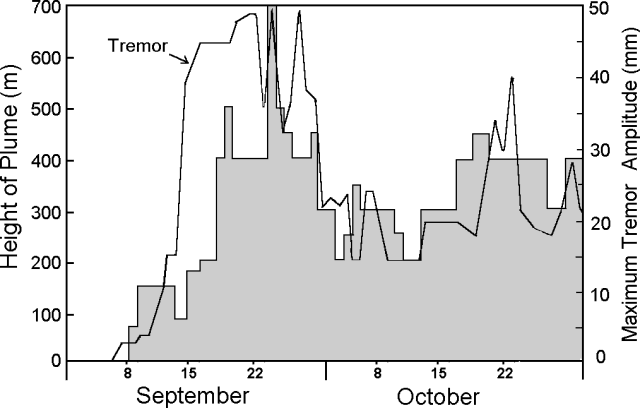Report on Tengger Caldera (Indonesia) — October 1995
Bulletin of the Global Volcanism Network, vol. 20, no. 10 (October 1995)
Managing Editor: Richard Wunderman.
Tengger Caldera (Indonesia) Eruption from Bromo sends dark ash plume 700 m above the rim
Please cite this report as:
Global Volcanism Program, 1995. Report on Tengger Caldera (Indonesia) (Wunderman, R., ed.). Bulletin of the Global Volcanism Network, 20:10. Smithsonian Institution. https://doi.org/10.5479/si.GVP.BGVN199510-263310
Tengger Caldera
Indonesia
7.942°S, 112.95°E; summit elev. 2329 m
All times are local (unless otherwise noted)
On 9 September, dark gray emissions were observed reaching a height of 70 m above the rim of Bromo Crater. Volcanic tremor associated with the emission events (maximum amplitude of 1-3 mm) was recorded continuously beginning on 8 September, using a PS-2 seismograph installed 750 m from the active crater. After 10 September the plume was denser than during the March-May 1995 activity (20:03). An international Notice to Airmen (NOTAM) on the morning of 22 September reported an ash cloud with a top at ~3 km altitude and a SW drift. The height of the ash column gradually increased, peaking at 700 m (~3 km altitude) on 25 September (figure 2); during the emission, maximum tremor amplitude was 49 mm. A thick dark gray ash cloud caused ashfall in nearby villages, reported as far away as ~20 km E (around the area of Sukapura). The eruption vent, with a diameter of ~25 m, was located on the N part of the crater floor, similar to the last eruption. Ash eruptions were continuing at the end of October, but the activity was gradually decreasing. In October the maximum plume height was 200-450 m above the crater rim; the maximum tremor amplitude was 8-40 mm.
 |
Figure 2. Height of ash plume and maximum tremor amplitude at Bromo, Tengger Caldera, September-October 1995. Courtesy of VSI. |
Geological Summary. The 16-km-wide Tengger caldera is located at the northern end of a volcanic massif extending from Semeru volcano. The massive volcanic complex dates back to about 820,000 years ago and consists of five overlapping stratovolcanoes, each truncated by a caldera. Lava domes, pyroclastic cones, and a maar occupy the flanks of the massif. The Ngadisari caldera at the NE end of the complex formed about 150,000 years ago and is now drained through the Sapikerep valley. The most recent of the calderas is the 9 x 10 km wide Sandsea caldera at the SW end of the complex, which formed incrementally during the late Pleistocene and early Holocene. An overlapping cluster of post-caldera cones was constructed on the floor of the Sandsea caldera within the past several thousand years. The youngest of these is Bromo, one of Java's most active and most frequently visited volcanoes.
Information Contacts: W. Tjetjep, VSI; BOM Darwin, Australia.

